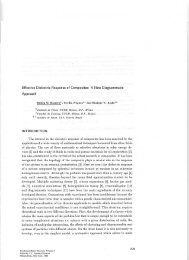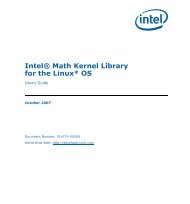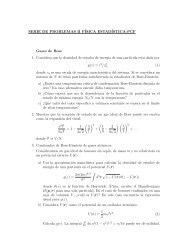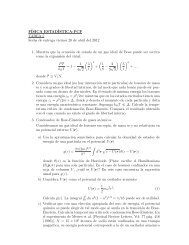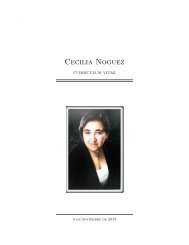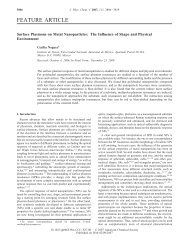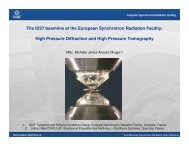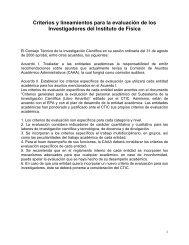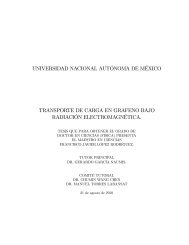Intrinsic Chirality in Bare Gold Nanoclusters: The Au34# Case - UNAM
Intrinsic Chirality in Bare Gold Nanoclusters: The Au34# Case - UNAM
Intrinsic Chirality in Bare Gold Nanoclusters: The Au34# Case - UNAM
Create successful ePaper yourself
Turn your PDF publications into a flip-book with our unique Google optimized e-Paper software.
J. Phys. Chem. C 2008, 112, 17533–17539 17533<br />
<strong>Intr<strong>in</strong>sic</strong> <strong>Chirality</strong> <strong>in</strong> <strong>Bare</strong> <strong>Gold</strong> <strong>Nanoclusters</strong>: <strong>The</strong> Au 34 - <strong>Case</strong><br />
Itzel E. Santizo, Francisco Hidalgo, Luis A. Pérez, Cecilia Noguez, and Ignacio L. Garzón*<br />
Instituto de Física, UniVersidad Nacional Autónoma de México, Apartado Postal 20-364,<br />
01000 México D. F., México<br />
ReceiVed: July 9, 2008; ReVised Manuscript ReceiVed: August 10, 2008<br />
In this work, we provide theoretical evidence on the existence of energetically stable chiral structures for<br />
bare gold clusters. Density functional theory calculations with<strong>in</strong> the generalized-gradient approximation were<br />
performed to systematically study structural, vibrational, electronic, and optical properties of the lowestly<strong>in</strong>g<br />
isomers of the Au 34Z ,(Z )+1, 0, -1), clusters. Our results show that for the neutral and charged<br />
clusters, the lowest-energy isomer has a C 1 (chiral) structure. In addition, a C 3 (chiral) isomer was found<br />
nearly degenerate <strong>in</strong> energy with the C 1 isomer. <strong>The</strong>se results are <strong>in</strong> agreement with previous theoreticalexperimental<br />
studies done for the Au 34- cluster; however, because our calculated molecular scatter<strong>in</strong>g functions<br />
for the C 1 and C 3 isomers of this cluster are almost <strong>in</strong>dist<strong>in</strong>guishable, it is concluded that the actual resolution<br />
<strong>in</strong> trapped ion electron diffraction experiments is not enough to discrim<strong>in</strong>ate between them. On the other<br />
hand, the electronic density of states of the C 1 isomer shows better overall agreement with the measured<br />
photoelectron spectrum of the Au 34- cluster than that one correspond<strong>in</strong>g to the C 3 isomer. <strong>The</strong> electronic<br />
density of states of these isomers also shows different features <strong>in</strong> the energy region of the HOMO-LUMO<br />
gap, which would generate dist<strong>in</strong>ct behavior <strong>in</strong> their optical properties. In fact, the calculated absorption and<br />
circular dichroism spectra of the two chiral isomers show clear differences <strong>in</strong> their l<strong>in</strong>e shape. Another important<br />
property that dist<strong>in</strong>guishes the C 1 and C 3 isomers is the different spatial distribution of the atomic coord<strong>in</strong>ation<br />
on the cluster surface. Our results confirm that the potential energy surface of bare gold clusters could have<br />
lowest-ly<strong>in</strong>g energy m<strong>in</strong>ima correspond<strong>in</strong>g to <strong>in</strong>tr<strong>in</strong>sically chiral structures.<br />
Introduction<br />
<strong>The</strong> theoretical and experimental study of energetically stable<br />
structures of gold clusters is an important and very active field<br />
of research. 1 By comb<strong>in</strong><strong>in</strong>g techniques like cluster ion mobility<br />
(CIM), 2 photoelectron spectroscopy (PES), 3,4 and trapped ion<br />
electron diffraction (TIED), 5 with density functional theory<br />
(DFT) calculations, <strong>in</strong>terest<strong>in</strong>g trends on the structural motifs<br />
of the lowest-energy isomers of gold clusters have been reported.<br />
For example, for anionic Au n- clusters with n < 13, 2D<br />
structures were proposed, 3,5 whereas for n ) 16-18 empty cagelike<br />
structures 6 have been detected. A perfect tetrahedron for<br />
the Au 20- cluster, 7 and tetrahedral-based structures 5,8,9 for n )<br />
21-23 have also been reported. For Au 24- , a hollow tubular<br />
structure was proposed, 5,8,9 but, <strong>in</strong>terest<strong>in</strong>gly, only up to n )<br />
25 a core-shell structure with a s<strong>in</strong>gle core atom was obta<strong>in</strong>ed. 9<br />
Another <strong>in</strong>terest<strong>in</strong>g case is the Au 32 neutral cluster with an<br />
I h cage-like structure that was theoretically predicted as the<br />
lowest-energy isomer; 10,11 however, PES measurements on the<br />
Au 32- cluster, taken at room temperature, <strong>in</strong>dicated that a lowsymmetry<br />
compact C 1 isomer fits best the experimental data. 12<br />
A recent theoretical study 13 showed that, although the lowestenergy<br />
structure of the Au 32 neutral cluster <strong>in</strong>deed corresponds<br />
to the I h cage-like structure, the energetic order<strong>in</strong>g of the lowestly<strong>in</strong>g<br />
isomers change for the anionic Au 32- cluster. In that<br />
study, 13 a systematic search of the lowest-energy m<strong>in</strong>ima was<br />
performed comb<strong>in</strong><strong>in</strong>g a global optimization technique (genetic<br />
algorithms) and a many-body Gupta potential with a further<br />
local m<strong>in</strong>imization, us<strong>in</strong>g DFT calculations with<strong>in</strong> the generalized-gradient<br />
approximation (GGA). <strong>The</strong> results obta<strong>in</strong>ed<br />
* To whom correspondence should be addressed. E-mail: garzon@<br />
fisica.unam.mx. Phone: +52-55-56225147. Fax: +52-55-561651535.<br />
showed that the lowest-energy isomer of the Au 32- cluster<br />
corresponds to a low-symmetry C 1 compact structure, <strong>in</strong>dicat<strong>in</strong>g<br />
that a s<strong>in</strong>gle additional charge is enough to modify the energetic<br />
order<strong>in</strong>g of the neutral cluster isomers. 13 This study also predicts<br />
that low-symmetry disordered structures, for both the Au 32- and<br />
the Au 32+ clusters, should be detected not only at room<br />
temperature as was experimentally verified for the Au 32- case 12<br />
but also at much lower temperatures. 13<br />
<strong>The</strong> search for the most stable structure of the large-band<br />
gap (0.94-0.96 eV) Au - 34 cluster has also received special<br />
attention recently. 14,15 In a theoretical-experimental study,<br />
comb<strong>in</strong><strong>in</strong>g PES, TIED, and time-dependent DFT calculations,<br />
it was suggested that an isomer with C 3 (chiral) po<strong>in</strong>t symmetry<br />
is the most abundant <strong>in</strong> the <strong>in</strong>vestigated ensemble of sizeselected<br />
clusters. 14 In other work, the structural and electronic<br />
properties of the Au 34- cluster were also <strong>in</strong>vestigated us<strong>in</strong>g<br />
accurate theoretical calculations and PES. 15 In contrast with the<br />
former study, 14 <strong>in</strong> the latter one, it was concluded that a<br />
disordered-fluxional isomer with C 1 po<strong>in</strong>t symmetry is the most<br />
likely candidate responsible of the PES data. 15 In both studies, 14,15<br />
it was also found that there are other lowest-ly<strong>in</strong>g isomers very<br />
close <strong>in</strong> energy with respect to either the C 3 or the C 1 isomers,<br />
but after a data analysis it was concluded that they only provide<br />
m<strong>in</strong>or contributions to the TIED 14 and PES 14,15 spectra. <strong>The</strong><br />
lack of agreement <strong>in</strong> the structure determ<strong>in</strong>ation of the isomers<br />
of the Au - 34 cluster that makes the major contribution to the<br />
TIED 14 and PES 14,15 data is surpris<strong>in</strong>g s<strong>in</strong>ce both studies used<br />
state of the art experimental techniques <strong>in</strong> conjunction with<br />
accurate quantum mechanical calculations. On the other hand,<br />
although the C 3 and C 1 isomers belong to different rotational<br />
symmetry groups, and therefore they are structurally different,<br />
10.1021/jp806080b CCC: $40.75 © 2008 American Chemical Society<br />
Published on Web 10/16/2008




